How much milk to feed a baby squirrel
Squirrel Feeding Amounts | Mysite
The first 12 to 24 hours the baby should be fed only an electrolyte hydration formula, such as Pedialyte for infants. Do not start feeding a baby until it is first warm, well hydrated, and has started to eliminate normally. Reference the links at the bottom of this page for more information on these topics.
If the baby has never had formula or is changing to a new brand, you must slowly introduce it over several feedings. Formula is never exactly like, or as good as, mother's natural milk. The baby's gastro- intestinal tract (gut) needs time to adjust to man-made formulas through slow introduction from the hydration fluid to full strength formula. Reference the section entitled, “Transitioning to Formula” at the bottom of the Feeding Technique page (Link at bottom).
Figuring Out How Much to Feed
The ideal amount to feed the baby at each feeding is up to 5% of its body weight at an interval that closely matches the frequency the mother would feed her young in the wild. Below is a rough guide to the amount and schedule for feeding a baby based on its approximate age and size.
It is highly recommended that you purchase a gram scale to reduce overfeeding. Baby squirrels are notorious hogs and will happily overeat. Overeating may result in life threatening diarrhea and easy predation by cats, hawks and other menaces that prefer chubby slow moving prey. Reference the link entitled, “Feeding complications” for more information.
If you don’t have a method of weighing the baby and are unsure of its age, you can roughly estimate it by comparing your squirrel to the ones pictured on the “How to determine the age of a baby squirrel” article (link to the right) available on the Chris’s Squirrels & More website.
The maximum amount should be no more than 5% in cc’s for the squirrel’s body weight in grams.
For example, if the squirrel weighs 100 grams (approximately 3.5 ounces), then 5% is 5 grams (.17 ounces) which translates to 5 cc (cubic centimeters) or ml (milliliter) or (1 tsp) of formula.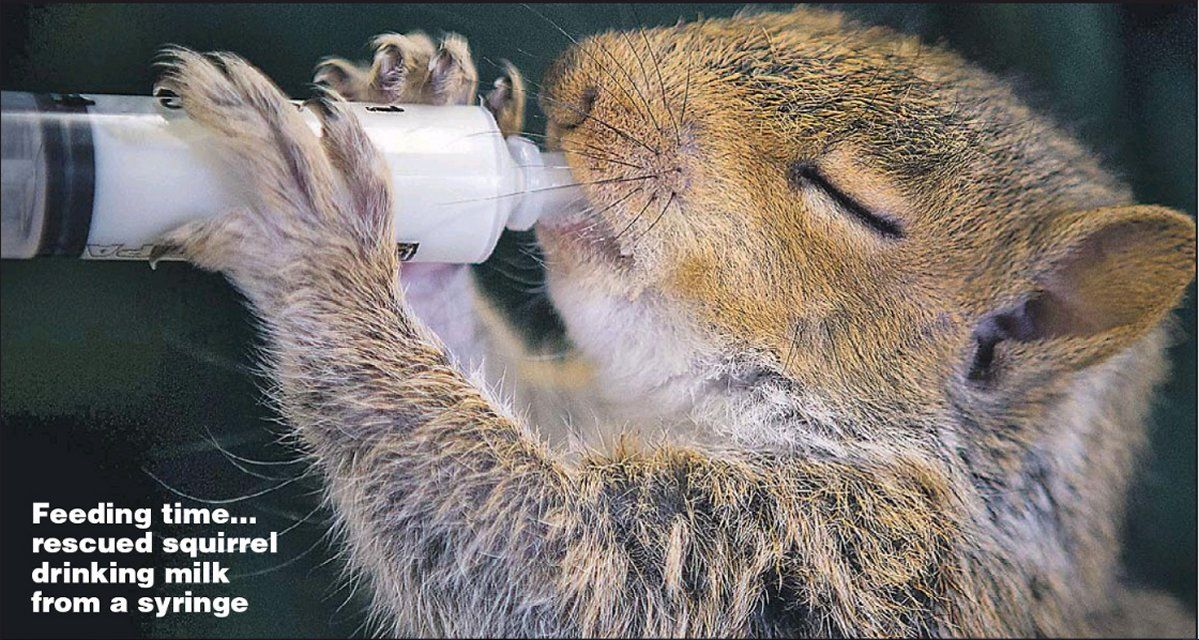
Table 1: Feeding Amounts by Weight
Figuring Out How Frequently to Feed
How often you feed a baby squirrel the amounts listed above depends on their age. Use Table 2 below to figure out how often to feed your babies based on their ages.
Here's an example based on Table 1 below:
A squirrel weighing 100 grams should be fed every 4 to 5 hours (reference Table 1 for squirrels weighing 120-160 grams) . The amount fed should be no more than of 5 cc (1/2 tsp*) of formula (reference Table 2 for amounts based on 100 grams of weight.
A note about frequency: It is ok to feed plus or minus 1/2 hour to accommodate scheduling for squirrels under 6 weeks. Older squirrels can be fed plus or minus 1 hour.
*Reference the Online Conversion Calculators if converting grams (weight) or cc’s (volume) to other measuring systems.
Table 2: Feeding Frequency by Age and Weight
Keeping Track of Feedings
It’s important that the baby doesn't get too much or too little formula to eat and that you know when it last eliminated (and if the product was normal - No blood in urine, loose or foul smelling stool!
Lack of normal appetite and abnormal bodily functions are important queues indicating a problem requiring immediate attention.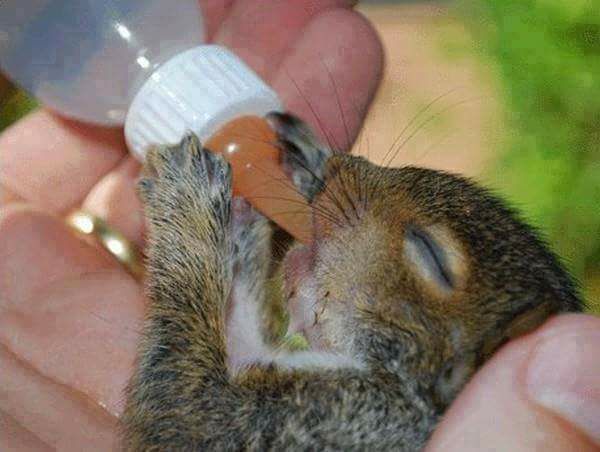
Keeping track can be especially hard when you have more than one care giver or multiple squirrels.
Our advice is, Write it down! Use our recommended daily care chart below.
If you are caring for multiple squirrels you might notice that it can be hard to tell who is who.
Consider using a temporary identification method such as a non-toxic nail polish or permanent Sharpie marker on an
ear or the tummy. You may need to reapply every few days.
If the squirrels are furred and you only have a small number , another option is to clip a small notch of fur from the tail at different locations.
Tail fur only replaces itself once a year, so don’t go crazy with this by trimming a large quantity of fur. Squirrels use their tails to communicate, for warmth, and balance.
Top Tips for the Safe Feeding of Squirrels
There are many things to consider for the proper feeding of baby squirrels, but here is a list of the top things you should know:
-
Do not add vitamins or minerals to any commercially prepared milk replacement product as they are already nutritionally complete.

-
Do not allow the baby to eat more than the recommended amount or frequency.
-
Never feed baby squirrels cow's milk, fruit juice, Tang, Sunny D or any other sweet drink! Really, Never!
-
Never attempt to feed a cold baby! Baby should feel warm in your hands. Feeding a cold baby will kill it because it cannot digest the formula when cold.
-
Never feed a baby on its back or too fast. Use a 1cc syringe on small babies to control the feed rate. Baby squirrels easily aspirate and choke.
-
Always stimulate the baby to urinate after feeding! An ‘eyes closed baby’ cannot eliminate without stimulation and will suffer a painful death without help.
-
Normal formula fed baby squirrel feces ranges from yellow to dark golden colored and is well formed like small seeds. If the stool becomes loose, smelly, watery, white or very pale then cut back on the concentration of formula or provide pedialyte for a few feedings until the feces is normal again.
 Adding a small amount of acidophilus or yogurt to the formula helps to keep the baby regular.
Adding a small amount of acidophilus or yogurt to the formula helps to keep the baby regular.
More Resources
Feeding Techniques
Learn how to properly and safely prepare food for and then feed your baby squirrel.
Feeding
Tools
Get recommendations for the best tools for the safe and proper feeding of baby squirrels.
Formula
Options
Get recommendations on the best formula to buy or make at home for baby squirrels.
Feeding Complications
Make yourself of what could go wrong during feeding, what signs to look for, and how to prevent it.
Warming Baby Squirrels
Before you feed, make sure your baby squirrel is safely warmed using our gentle and simple methods.
Treating Dehydration
Learn the signs of dehydration in baby squirrels and how to treat them.
Potty
Stimulation
Learn how to safely stimulate your baby squirrel until they are able to potty themselves.
Squirrel
Board
Have more questions? Ask the Squirrel Board, a forum managed by rehabbers and experts.
Baby Squirrel Care - Formula Feeding
Once the baby squirrel is warm and has had some hydration fluid, you are ready to start feeding. What do baby squirrels eat? Formula, also called “milk replacer.”
Formula Recommendations for Different Ages
- Pinkies less than 10 days old: Homemade Goat Milk Formula for 10 days, then switch to either Esbilac Puppy Milk powder, or Fox Valley 32/40, then switch to Fox Valley 20/50 by 4 weeks old.
- 10 days old to 2 weeks old: HGMF or Esbilac until you receive your Fox Valley 32/40, then switch to Fox Valley 20/50
- 3 weeks and older: HGMF or Esbilac until you receive your Fox Valley 20/50
HGMF works the BEST for tiny pinkies in our experience.
Homemade Goat Milk Formula Plus (HGMF+):
- 3 tablespoons goat milk
- 3 tablespoons plain yogurt
- 2 tablespoons heavy cream
- ½ egg yolk
You can buy goat milk at most grocery stores.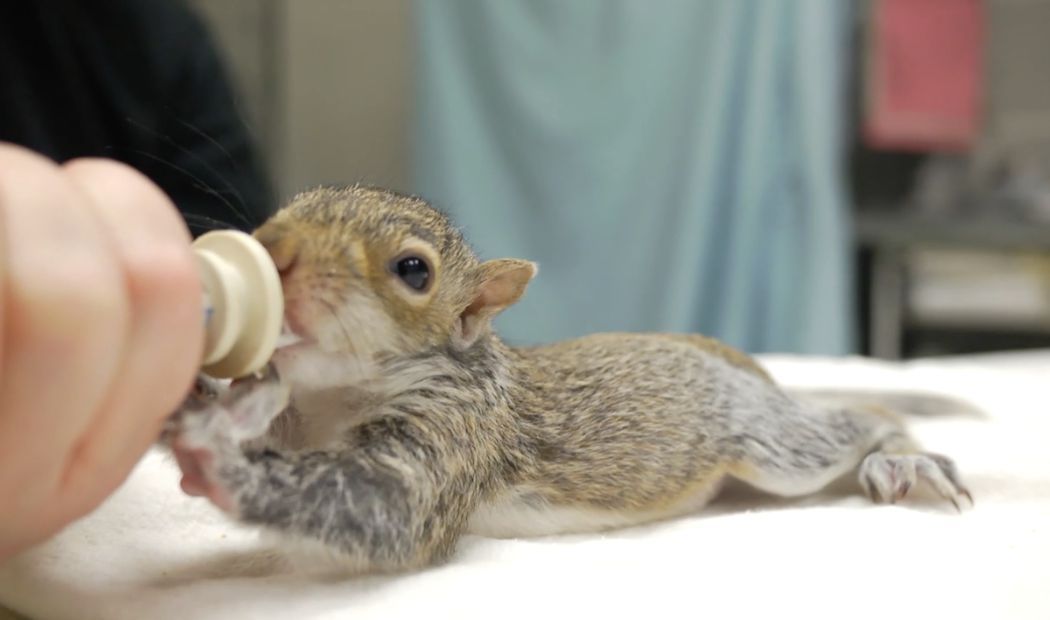 If you can't find fresh goat milk, you can use canned or powdered. Note: Canned or powdered milk must be mixed with water FIRST according to label directions. Do not use HGMF+ for more than two weeks at a time as it is not fully fortified with vitamins/minerals. If you can't find goat milk, double the yogurt (6 tablespoons).
If you can't find fresh goat milk, you can use canned or powdered. Note: Canned or powdered milk must be mixed with water FIRST according to label directions. Do not use HGMF+ for more than two weeks at a time as it is not fully fortified with vitamins/minerals. If you can't find goat milk, double the yogurt (6 tablespoons).
Be alert for bloating, diarrhea or constipation, and take immediate action. See page 5, "Common Problems."
Make sure formula is very, very warm. Baby squirrels will not drink enough formula if it is only slightly warm....they will starve to death!
Mixing, Feeding and Storing Formula
- When using a powdered formula, mix with very warm water. Allow the formula to sit for a while (or overnight) in the fridge so it dissolves.
- Before each feeding, stir the formula and draw up enough syringes of cold formula for the feeding.
- Microwave a coffee mug of water until it is hot (but not boiling).
 Then dunk the filled syringes in the hot water. They will take around 30 to 60 seconds to heat up.
Then dunk the filled syringes in the hot water. They will take around 30 to 60 seconds to heat up. - Take one syringe out, tilt it to mix the formula within the syringe, and test it on your wrist before feeding (should be VERY warm).
- If the formula in your syringe gets too cool while feeding, re-dunk it and pull out another syringe.
- Discard made-up formula after 24 hours.
7% Feeding Rule:
Weigh the baby on a scale in GRAMS; multiply that number by 7% (.07) and that will be the number of cc's (or ml's) to feed per feeding. You may need to start with smaller feedings at first, and work up to 7% after a few feedings, especially for emaciated babies.
Do not overfeed or increase feeding amounts too quickly! Baby squirrels will overeat if you let them and get diarrhea or bloating, which can be fatal. Weigh the baby every day at the same time to determine if they are gaining or losing weight and adjust the formula amount as needed.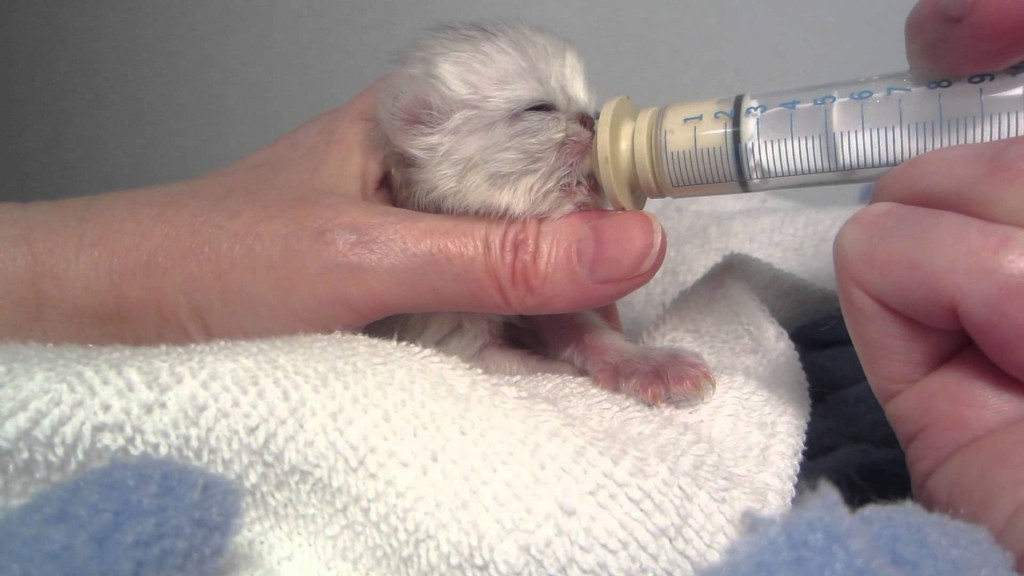
EXAMPLE:
Squirrel weighs 50 grams
50 x 7% = 3.5 (Using a calculator, it's 50 x .07 = 3.5)
So you feed 3.5 cc's per feeding
Potty Time
A baby squirrel less than 5 weeks old will need to be stimulated to poop and pee. Use a warm, wet cotton ball, Q-tip, the corner of a Kleenex, or your finger, and flick lightly across the genital area. Some babies may need stimulation before and after feeding. A few may eat better if you potty them in the middle of a feeding.
NOTE: Baby squirrels need lots of attention and affection, especially if he has no siblings. This will not hinder the release process in any way. Squirrels bond strongly with their human caretakers, but they do not "imprint" on humans like other wildlife. When it's time for release, their wild instincts will kick in just fine.
Don’t use cheap syringes that stick; use quality o-ring syringes and go slow to avoid aspiration!
PRINT THIS GUIDE
Sumy region veterinary - How to feed a baby squirrel?
What to feed the squirrel?
One of the products that I use in feeding baby squirrels is Esbilac milk replacer for puppies. You can purchase it at most pet stores.
You can purchase it at most pet stores.
Esbilac may be sold in powder or liquid form. I prefer to buy Esbilac powder. Do not buy instead of Esbilak its substitutes that you can offer in the store. At the same time, get a few syringes in the store (or pharmacy), but without needles.
You can pick up a gift for your loved one in the online store dom-podarka.ru.
Never, ever use bottles with nipples when feeding a squirrel! The squirrel can suffocate because of them!
Instead of bottles, you will need 1 to 3 unit syringes for feeding very young squirrels, and 5 to 10 unit syringes for feeding slightly older squirrels.
Instead of needles, you need to put small papillae on syringes, which can be sold in pet stores.
If you cannot find such small papillae, then use a pipette, but in this case, be extremely careful not to feed the squirrel too quickly, otherwise it may choke.
Mix 2 parts liquid esbilac with 1 part water (if using powdered esbilac add 2 parts water to 1 part esbilac). You can also add just a little fruity sweetener for kids. Only quite a bit! You can use fruit banana sweetener - squirrels really like this taste.
You can also add just a little fruity sweetener for kids. Only quite a bit! You can use fruit banana sweetener - squirrels really like this taste.
You can also add some yoghurt to the nutritional formula.
Mix the formula in a clean jar and then store the mixture in the refrigerator.
Then, for each feeding, heat only the part of the formula that will be used for that feeding.
When heating the mixture in the microwave, be careful not to heat the mixture too hot.
Then draw the formula into the syringe and feed the squirrel very carefully.
When feeding, I lay the older baby squirrels on a flat surface and feed them in that position. If the squirrels are still too small, then you can feed them by holding them in your hand.
Be very careful and slow to prevent the squirrel from drowning.
Sometimes a baby squirrel can suckle formula so fast that it starts to choke. In this case, you need to immediately stop feeding and hold the baby upside down so that excess fluid can flow back out. After that, you need to wipe the squirrel's nose and mouth and then continue feeding, only more slowly.
After that, you need to wipe the squirrel's nose and mouth and then continue feeding, only more slowly.
A very small baby squirrel with hair that is still completely missing or has barely begun to grow, needs to be fed regularly every 2-3 hours, as thin squirrels cannot eat enough at one meal.
Baby squirrels at two to three weeks of age should be fed regularly every 3-4 hours.
Three to five week old baby squirrels need to be fed every 4-5 hours.
At the age of five weeks, squirrels should be fully furred and their eyes should be opening. At this age, they can be fed every four hours during the day, and can no longer be fed at night.
The amount of food a baby squirrel needs at each meal is not strictly defined. The squirrel may eat a little more or a little less.
Here is an approximate feeding schedule for baby squirrels depending on their age:
- From one day to two weeks old: 0.5-2 cc. see for each meal, 6-8 feedings per day.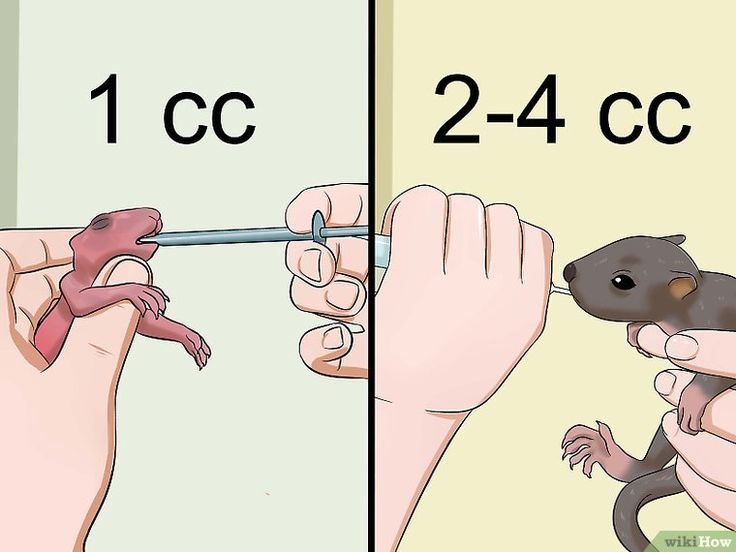
- 2 to 4 weeks old: 2-4 cc. see for each meal, 5 or 6 feedings during the day.
4 to 6 weeks of age: 4-6 (or even more) cc. see for each meal, 4 meals during the day, you can no longer feed at night.
From the age of six weeks, squirrels can already eat more solid food (zu prem biscuit and small pieces of plant food) in addition to the nutritional formula that they need to be given in a volume of 6-12 cc. see at every meal. Squirrels of this age need to be fed 2-3 times a day.
I always give baby squirrels a nutritional formula until then. Until they give up on it.
Also squirrels are given goat's milk with the following calculation:
1 day - 1:4 (goat's milk:water)
Day 2 - 1:3 (goat's milk:water)
Day 3 - 1:2 (goat's milk:water)
If a baby squirrel is fed goat's milk, its feces are like yellow toothpaste. If the feces become more liquid, start giving the squirrel the mixture as on the first day (1:4).
Squirrel must always be clean.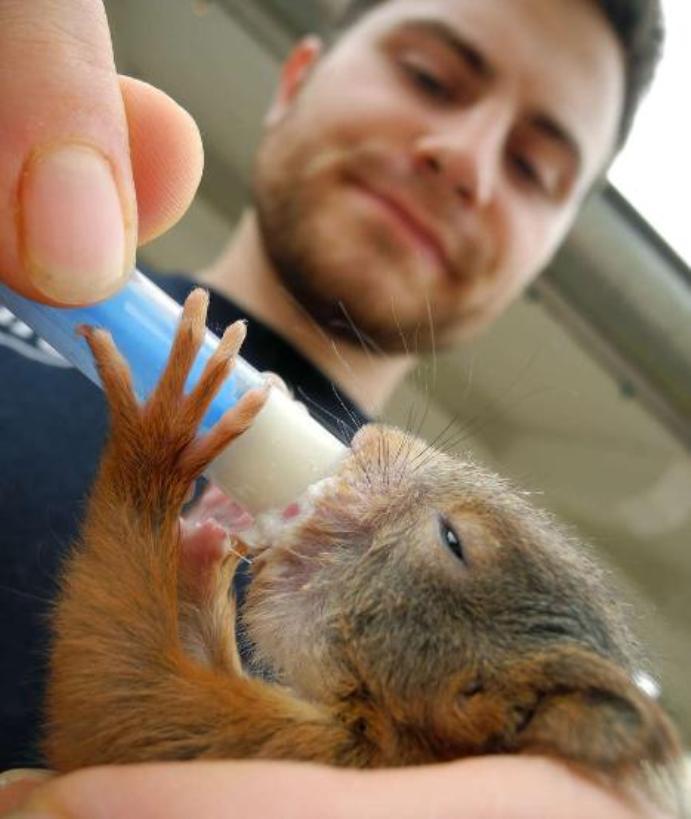 After each feeding, wipe around the mouth with a damp cloth. Gently clean the genitals and anus several times a day (more often if necessary).
After each feeding, wipe around the mouth with a damp cloth. Gently clean the genitals and anus several times a day (more often if necessary).
Vitamins must be added to goat's milk mixture. Very tiny squirrels are given one drop twice a day during the first week of feeding. Squirrels of three weeks of age are given one drop 3 times a day. When the squirrel opens his eyes, give him two drops of vitamins 3 times a day.
Friday, May 14, 2010. Author: Andrey Kletsov Posted in News
Kletsov Andrey Mikhailovich
Veterinarian Kletsov Andrey Mikhailovich.
Graduated from the Sumy National Agrarian University in 2003 and received a diploma in veterinary medicine. From 2003 to 2005, he worked as a doctor, and a little later, as the head of the anti-epizootic department of the state veterinary hospital in the Sumy region. In 2007 he received a master's degree in veterinary medicine.
Clinic "Vetpomoshch", Sumy, Ukraine.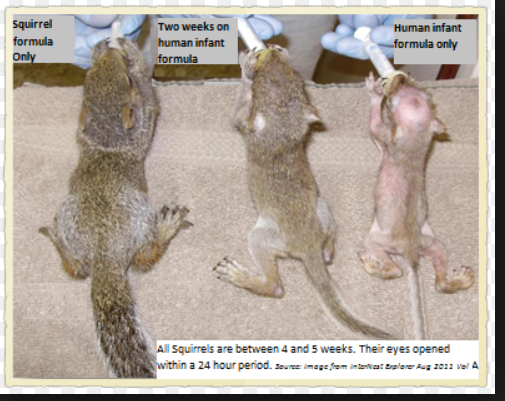
- http://vet.sumy.ua
Squirrel
A fur-bearing animal that leads an arboreal lifestyle. The common squirrel is distributed throughout almost the entire territory of Eurasia.
Squirrels are cute but wild animals. Not every animal can become so tame that you can safely let it out around the room and even pick it up. Adults picked up from the street, as a rule, remain wild, never getting used to human care. A rescued baby that has fallen out of the nest can become a true friend for you, as it will get used to you from an early age.
Picking up a squirrel or an adult squirrel, you let one more family member into your house and thus take responsibility for its future fate.
Adult individuals fall into the hands of a person with various diseases, since a healthy animal is quite dexterous, and it is almost impossible to catch it. The most common ailments are all kinds of injuries: fractures, dislocations, biting wounds, and so on. As well as infectious diseases that can be dangerous to humans. Therefore, having picked up a squirrel, the first thing to do is to show it to a veterinarian who will conduct a full clinical examination, and, if necessary, prescribe additional laboratory tests (analyzes, ultrasound, x-rays, etc.), prescribe treatment and give you advice on care, maintenance and feeding the animal.
Therefore, having picked up a squirrel, the first thing to do is to show it to a veterinarian who will conduct a full clinical examination, and, if necessary, prescribe additional laboratory tests (analyzes, ultrasound, x-rays, etc.), prescribe treatment and give you advice on care, maintenance and feeding the animal.
Squirrels give birth to two litters per year from 2 to 12 cubs each. The first estrus occurs in January-March, the second - in the summer. Duration of pregnancy, on average 30-40 days.
Baby squirrels are born naked and blind, with a body length of 5-5.6 cm and a weight of 7.5-8.5 g. On the 14th day, hair begins to appear. The incisors erupt on the lower jaw on the 21-23rd day, on the upper - on the 37-41th day. Eyes open at 30-32 days. At the same time, baby squirrels wake up with a wild interest in the environment, they look out of the nest and, due to their inexperience, can fall out.
At 14-21 days the squirrels are overgrown with thin fur, eyes are closed, weight 35-60 g, body length 12. 5-17.7 cm.
5-17.7 cm.
At 40 days they try to find food themselves.
They start independent life at two months.
Puberty at 5 months.
If you picked up a baby, it must be warmed, watered and fed. The optimum temperature for a squirrel is 27ºС.
Suitable for feeding: cow's or goat's milk diluted 1:1 with boiled water or milk replacer for kittens. Feed carefully one drop from a pipette so that the baby does not choke. Massage your tummy before and after every feeding.
If the squirrel begins to choke, stop feeding, hold him upside down and wipe his nose and mouth, then continue to feed even more slowly.
Approximate feeding schedule for baby squirrels depending on age:
| Age | Meal per meal | Feeding frequency | Feeding interval |
| 1 day to 14 days | 0. 5 - 2 ml 5 - 2 ml | 6 - 8 times a day | 2 - 3 hours |
| 14 -28 days | 2 - 4 ml | 5-6 times a day | 3-4 hours |
| 4 - 6 weeks | 4 - 6 ml or more | 4 times a day (you can stop feeding at night) | 4 - 5 hours |
| From 6 weeks | 6 - 12 ml | 2 - 3 times a day | 6 – 12 noon |
From the age of six weeks, squirrels can eat more solid food: white bread soaked in goat's milk. Gradually, “adult” food is included in the diet (at first in crushed form). Milk mixture can be given until the animal itself refuses it.
An adult squirrel is fed twice a day, offering a variety of foods: pine nuts, hazelnuts and walnuts in the shell, acorns, raw pumpkin and sunflower seeds (not fried!), dry and fresh mushrooms, bananas, apples, pears, dried fruits, carrots , white crackers, raspberries, blueberries, blueberries, mountain ash, viburnum, bark, buds, shoots, cones of firs and pines, raw and boiled quail and chicken eggs, egg shells, chalk, charcoal, flour worms, low-fat cottage cheese, butter ( rare and few).
Almonds are poison for squirrels!
Approximate daily ration for a squirrel: 10-15 g of white bread (not rich), 15-20 g of nuts, 20-25 g of fruits and berries (dried fruits in winter).
Extract from the Diet Book:
| No. p/n | Designation | Periodicity of issue | Quantity g/1 head/day |
| 1 | Wheat bread | daily | 10 |
| 2 | Hazelnuts | daily | 10 |
| 3 | Walnuts | two days later | 10 |
| 4 | Pine nuts | daily | 10 |
| 5 | Ground nuts | daily | 10 |
| 6 | Chestnut | every other day | 10 |
| 7 | Sunflower seeds | daily | 10 |
| 8 | Pumpkin seeds | daily | 10 |
| 9 | Apples | every other day | 5 |
| 10 | Carrot | every other day | 5 |
| 11 | Cabbage | every other day | 5 |
| 12 | Fruits, berries | daily | 2 |
| 13 | Dried fruits | daily | 2 |
| 14 | Sugar Cookies | for work | 2 |
| 15 | Hemp | daily | 2 |
| 16 | Dry mushrooms | daily | 2 |
| 17 | Salad | daily | 2 |
| 18 | Curd | daily | 2 |
| 19 | Milk | daily | 3 |
| 20 | Butter | daily | 2 |
| 21 | Chicken egg | every other day | 1 |
| 22 | Honey | alternate | 2 |
| 23 | Jam | alternate | 2 |
| 24 | Salt | daily | 2 |
| 25 | Chalk | alternate | 2 |
| 26 | Bone meal | alternate | 2 |
| 27 | flour worm | daily | 2 |
| 28 | Fish | daily | 2 |
| 29 | Grass, branches | daily | to your heart's content |
| 30 | Cones | daily | to your heart's content |
| 31 | Needles | daily | ad libitum |
In winter, to prevent beriberi, honey or vitamins A, D, E in oil can be added to food or drink 1 drop per animal once a week.
Do not use boiled or tap water, filtered water or well water will do. Water is changed twice a day. Squirrels willingly drink milk, juices and tea.
All products must be fresh and of good quality.
Do not feed the squirrel spicy, salty, smoked, fried, with spices, etc. Do not abuse sweets.
If possible, an outdoor enclosure should be built for the squirrel. Approximate dimensions are 2x1.5x1.5 m. Three walls are made of a metal mesh with cells of 10-15 mm2. The fourth wall and the roof are made deaf. Along the perimeter, boards are made 10–20 cm high in order to protect the animal from possible pests (cats, dogs, etc.). For ease of cleaning, you need a door that should close well. A snag with branches and wooden shelves are placed inside the enclosure, along which the animal will frolic, and on which it will grind its claws. Also, the squirrel needs a house - shelter. It is necessary to provide building material for home improvement - it can be wool, scraps of fabric, and so on.
Feeders and drinkers must be securely fastened so that the animal cannot knock them over.
If it is not possible to keep the squirrel in an aviary, you will need a cage with a minimum size of 60x50x50 cm. The frame must be metal, otherwise the squirrel will be able to get free. Outside the cage it is worth equipping the wheel. Wooden shelves and driftwood are placed in the cage, as well as a shelter house and landscaping material.
The cage is placed opposite the window. If the cage is to be moved outside or onto a balcony, a solid roof is required, as squirrels are very sensitive to direct sunlight and are easily subject to sun and heat shock.
In nature, squirrels are more active in the morning and at dusk, but they can also adapt to other modes.
Cleaning should be done 2-3 times a week, but at least once a week. Squirrels are very attached to their smell, so do not use detergents. Frequent cleaning will save you from unpleasant odors. Once a month, it is worth pouring boiling water over all interior items and a cage for disinfection.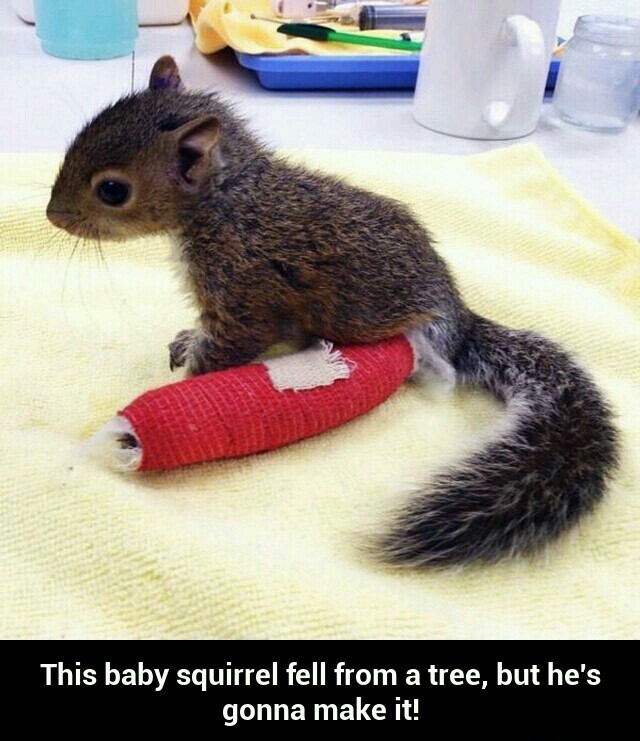
Squirrels molt twice a year: in autumn they change their red summer clothes for gray winter clothes, and vice versa in spring.
The squirrel needs your attention all the time.
If you picked up a squirrel and fed it with a pipette, in the wild it will not be able to feed itself on its own, because it simply does not know how to do it. Such an animal cannot be released into the wild, it will not be able to live without your care.
If you picked up an adult sick squirrel and left it, but it did not become tame, you should think about returning it to nature. It is best to do this in April - May, when the spring rut is over, in order to avoid violence from relatives, and there is still a whole summer ahead and the animal will have time to acquire supplies for the winter. It is necessary to release the squirrel into the wild into the habitual halo of habitat - to where you took it from.
And remember: a squirrel, like any other animal, is a potentially dangerous source of infectious, invasive and parasitic diseases for humans!
Veterinary doctor
For any questions regarding the health of your pets
, you can contact our clinic at:
st.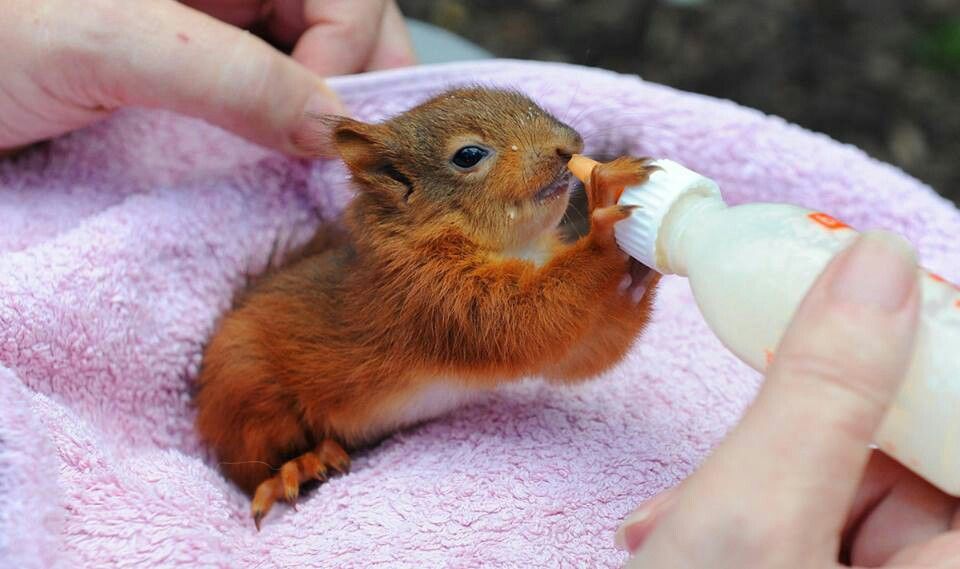


.jpg)








